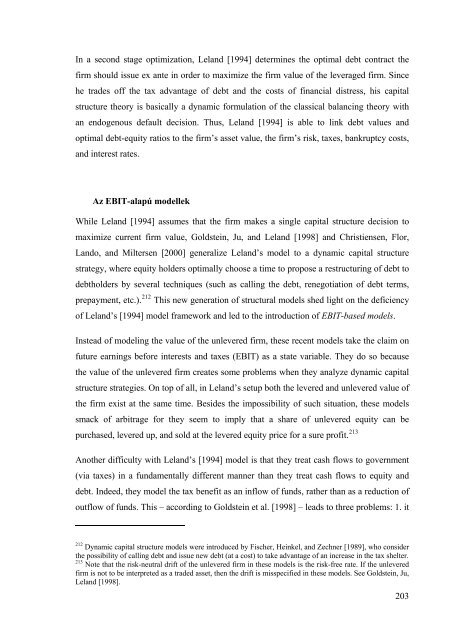értekezés - Budapesti Corvinus Egyetem
értekezés - Budapesti Corvinus Egyetem
értekezés - Budapesti Corvinus Egyetem
You also want an ePaper? Increase the reach of your titles
YUMPU automatically turns print PDFs into web optimized ePapers that Google loves.
In a second stage optimization, Leland [1994] determines the optimal debt contract the<br />
firm should issue ex ante in order to maximize the firm value of the leveraged firm. Since<br />
he trades off the tax advantage of debt and the costs of financial distress, his capital<br />
structure theory is basically a dynamic formulation of the classical balancing theory with<br />
an endogenous default decision. Thus, Leland [1994] is able to link debt values and<br />
optimal debt-equity ratios to the firm’s asset value, the firm’s risk, taxes, bankruptcy costs,<br />
and interest rates.<br />
Az EBIT-alapú modellek<br />
While Leland [1994] assumes that the firm makes a single capital structure decision to<br />
maximize current firm value, Goldstein, Ju, and Leland [1998] and Christiensen, Flor,<br />
Lando, and Miltersen [2000] generalize Leland’s model to a dynamic capital structure<br />
strategy, where equity holders optimally choose a time to propose a restructuring of debt to<br />
debtholders by several techniques (such as calling the debt, renegotiation of debt terms,<br />
prepayment, etc.). 212 This new generation of structural models shed light on the deficiency<br />
of Leland’s [1994] model framework and led to the introduction of EBIT-based models.<br />
Instead of modeling the value of the unlevered firm, these recent models take the claim on<br />
future earnings before interests and taxes (EBIT) as a state variable. They do so because<br />
the value of the unlevered firm creates some problems when they analyze dynamic capital<br />
structure strategies. On top of all, in Leland’s setup both the levered and unlevered value of<br />
the firm exist at the same time. Besides the impossibility of such situation, these models<br />
smack of arbitrage for they seem to imply that a share of unlevered equity can be<br />
purchased, levered up, and sold at the levered equity price for a sure profit. 213<br />
Another difficulty with Leland’s [1994] model is that they treat cash flows to government<br />
(via taxes) in a fundamentally different manner than they treat cash flows to equity and<br />
debt. Indeed, they model the tax benefit as an inflow of funds, rather than as a reduction of<br />
outflow of funds. This – according to Goldstein et al. [1998] – leads to three problems: 1. it<br />
212 Dynamic capital structure models were introduced by Fischer, Heinkel, and Zechner [1989], who consider<br />
the possibility of calling debt and issue new debt (at a cost) to take advantage of an increase in the tax shelter.<br />
213 Note that the risk-neutral drift of the unlevered firm in these models is the risk-free rate. If the unlevered<br />
firm is not to be interpreted as a traded asset, then the drift is misspecified in these models. See Goldstein, Ju,<br />
Leland [1998].<br />
203
















